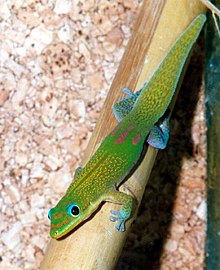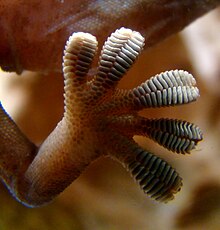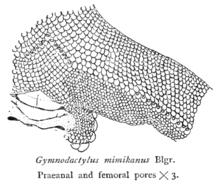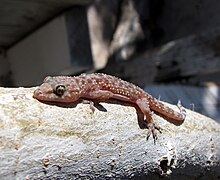Another resident of the Hawaiian Islands is the Gecko. I have seen green ones and golden ones here before. I mostly saw them on Maui and the big island of Hawaii. They would usually be near screen doors (before going into a home or just inside the door of the home. They would usually wait on a wall or the ceiling to catch insects with their long tongues. And they make a sound of "Geecko! Geecho" Gheeko!" This is usually how you find them when they make this sound. I always found them sort of sweet to have as company just outside or even inside your home. And if they didn't catch any insects often you would find them dried up just outside your door or inside of your door. But, there company was always a good company to have. They are good luck in this way.
Gold dust day geckos are only the latest moʻo to make Maui home ...
mauiinvasive.org/2016/06/21/gold-dust-day-geckos/
Jun 21, 2016 - Geckos are ubiquitous throughout the Hawaiian Islands today, but that was not always the case. Though lizards can colonize islands by ...
Apr 24, 2017 - None of the nine gecko species found in the Hawaiian Islands are native. Some, such as the stump-toed gecko and the Indopacific tree gecko, ...
Guardian Geckos - History, Facts & Lore Behind Hawaiian Geckos
www.coffeetimes.com/geckos.htm
The geckos of Hawaii have earned a great reputation rooted in the earliest history and the first migrations to the islands.
Herping In Hawaii - Reptiles Magazine
www.reptilesmagazine.com/Field-Herping/Herping-In-Hawaii/
In fact, according to the late Sean McKeown, author of "A Field Guide to Reptiles and Amphibians in the Hawaiian Islands", these two day geckos feed on ...
- from Wikipedia:begin quote from:in more light. Geckos are unique among lizards in their vocalizations. They use chirping sounds in social interactions with other geckos. They are the31 KB (3,622 words) - 20:24, 26 September 2017
-
gecko (Gekko gecko) is a nocturnal arboreal gecko in the genus Gekko, the true geckos. It is native to Asia and some Pacific Islands. The tokay gecko9 KB (930 words) - 05:18, 27 August 2017
-
Phelsuma laticauda angularis. This lizard belongs to the smaller day geckos, and can reach a total length of about 15–22 cm (6–9 in). The body colour5 KB (477 words) - 21:40, 8 Ma
Gecko

It has been suggested that Gekkota be merged into this article. (Discuss) Proposed since March 2016.
Geckos are lizards belonging to the infraorder Gekkota, found in warm climates throughout the world. They range from 1.6 to 60 cm (0.64 to 24 inches). Most geckos cannot blink, but they often lick their eyes to keep them clean and moist. They have a fixed lens within each iris that enlarges in darkness to let in more light.Gecko
Temporal range: 110 Ma – present[1]
Gold dust day gecko Scientific classification 
Kingdom: Animalia Phylum: Chordata Class: Reptilia Order: Squamata Infraorder: Gekkota
Cuvier, 1817Families Pygopodidae
Carphodactylidae
Diplodactylidae
Eublepharidae
Sphaerodactylidae
Gekkonidae
Phyllodactylidae
Geckos are unique among lizards in their vocalizations. They use chirping sounds in social interactions with other geckos. They are the most species-rich group of lizards, with about 1,500 different species worldwide.[2] The New Latin gekko and English "gecko" stem from the Indonesian-Malay gēkoq, which is imitative of the sound the animals make.[3]
All geckos, excluding the Eublepharidae family, lack eyelids and instead have a transparent membrane, which they lick to clean.[4] Nocturnal species have an excellent night vision; their color vision is 350 times more sensitive than human color vision.[5] The nocturnal geckos evolved from diurnal species which had lost the eye rods. The gecko eye therefore modified its cones that increased in size into different types both single and double. Three different photopigments have been retained and are sensitive to UV, blue, and green. They also use a multifocal optical system that allows them to generate a sharp image for at least two different depths.[6][7]
Most gecko species can lose their tails in defense, a process called autotomy.[8] Many species are well known for their specialised toe pads that enable them to climb smooth and vertical surfaces, and even cross indoor ceilings with ease. Geckos are well-known to people who live in warm regions of the world, where several species of geckos make their home inside human habitations. These (for example the house gecko) become part of the indoor menagerie and are often welcomed, as they feed on insects, including moths and mosquitoes. Unlike most lizards, geckos are usually nocturnal.
The largest species, the kawekaweau, is only known from a single, stuffed specimen found in the basement of a museum in Marseille, France. This gecko was 60 cm (24 in) long and it was likely endemic to New Zealand, where it lived in native forests. It was probably wiped out along with much of the native fauna of these islands in the late 19th century, when new invasive species such as rats and stoats were introduced to the country during European colonization. The smallest gecko, the Jaragua sphaero, is a mere 1.6 cm long and was discovered in 2001 on a small island off the coast of the Dominican Republic.[9]
Contents
Common traits
Geckos occur in various patterns and colors, and are among the most colorful lizards in the world. Some species can change colour and may be lighter in colour at night.[citation needed] Some species are parthenogenetic, which means the female is capable of reproducing without copulating with a male.[citation needed] This improves the gecko's ability to spread to new islands. However, in a situation where a single female gecko populates an entire island, the island will suffer from a lack of genetic variation within the geckos that inhabit it.[citation needed] The gecko's mating call sounds like a shortened bird chirping which attracts males, when they are nearby.[citation needed] Like other reptiles, geckos are ectothermic,[10] producing very little metabolic heat. Essentially a gecko's body temperature is dependent on its environment. Also, in order to accomplish their main functions—such as locomotion, feeding, reproduction, etc.—geckos must have a relatively elevated temperature.[10]
Shedding or molting
All geckos shed their skin at fairly regular intervals, with species differing in timing and method. Leopard geckos will shed at about two- to four-week intervals. The presence of moisture aids in the shedding. When shedding begins, the gecko will speed the process by detaching the loose skin from its body and eating it.[11]Video of Leopard gecko shedding skin
Adhesion ability
Close-up of the underside of a gecko's foot as it walks on vertical glassAbout 60% of gecko species have adhesive toe pads that allow them to adhere to most surfaces without the use of liquids or surface tension. Such pads have been gained and lost repeatedly over the course of gecko evolution.[12] Adhesive toepads evolved independently in about 11 different gecko lineages and were lost in at least 9 lineages.[12] The spatula-shaped setae arranged in lamellae on gecko footpads enable attractive van der Waals' forces between the β-keratin lamellae/setae/spatulae structures and the surface.[13][14] These van der Waals interactions involve no fluids; in theory, a boot made of synthetic setae would adhere as easily to the surface of the International Space Station as it would to a living-room wall, although adhesion varies with humidity.[15][16] The setae on the feet of geckos are also self-cleaning and will usually remove any clogging dirt within a few steps.[17][18] [19] Teflon, which has very low surface energy,[20] is more difficult for geckos to adhere to than many other surfaces.Gecko on window pane
Increasing humidity typically fortifies gecko adhesion,[15][16][21][22][23] even on hydrophobic surfaces, yet is reduced if completely immersed in water. The role of water in that system is under discussion, yet recent experiments agree that the presence of molecular water layers (water molecules carry a very large dipole moment) on the setae as well as on the surface increase the surface energy of both, therefore the energy gain in getting these surfaces in contact is enlarged, which results in an increased gecko adhesion force.[15][16][21][22][23] Moreover, the elastic properties of the b-keratin change with water uptake.[15][16][21] Friction experiments with gecko toes—torn parallel to surfaces—have shown to be influenced also by electrostatic forces.[24]
Gecko toes seem to be "double jointed", but this is a misnomer and is properly called digital hyperextension.[25] Gecko toes can hyperextend in the opposite direction from human fingers and toes. This allows them to overcome the van der Waals force by peeling their toes off surfaces from the tips inward. In essence, by this peeling action, the gecko separates spatula by spatula from the surface, so for each spatula separation, only some nN are necessary. (The process is similar to removing scotch tape from a surface.)
Geckos' toes operate well below their full attractive capabilities most of the time, because the margin for error is great depending upon the surface roughness, and therefore the number of setae in contact with that surface.
Use of small van der Waals attraction force requires very large surface areas: every square millimeter of a gecko's footpad contains about 14,000 hair-like setae. Each seta has a diameter of 5 μm. Human hair varies from 18 to 180 μm, so the cross-sectional area of a human hair is equivalent to 12 to 1300 setae. Each seta is in turn tipped with between 100 and 1,000 spatulae.[17] Each spatula is 0.2 μm long[17] (one five-millionth of a meter), or just below the wavelength of visible light.[26]Uroplatus fimbriatus clinging to glass
The setae of a typical mature 70 g (2.5 oz) gecko would be capable of supporting a weight of 133 kg (293 lb):[27][28] each spatula can exert an adhesive force of 5 to 25 nN.[21][29] The exact value of the adhesion force of a spatula varies with the surface energy of the substrate to which it adheres. Recent studies [23][30] have moreover shown that the component of the surface energy derived from long-range forces, such as van der Waals forces, depends on the material's structure below the outermost atomic layers (up to 100 nm beneath the surface); taking that into account, the adhesive strength can be inferred.
Recent studies have also revealed that apart from the setae, phospholipids—fatty substances produced naturally in their bodies—also come into play.[31] These lipids lubricate the setae and allow the gecko to detach its foot before the next step.
The origin of gecko adhesion likely started as simple modifications to the epidermis on the underside of the toes. This was recently discovered in the genus Gonatodes from South America.[32] Simple elaborations of the epidermal spinules into setae have enabled Gonatodes humeralis to climb smooth surfaces and sleep on smooth leaves.
Biomimetic technologies designed to mimic gecko adhesion could produce reusable self-cleaning dry adhesives with many applications. Development effort is being put into these technologies, but manufacturing synthetic setae is not a trivial material design task.
Skin
Gecko skin does not generally bear scales but appears at a macro scale as a papillose surface which is made from hair-like protuberances developed across the entire body. These confer superhydrophobicity and the unique design of the hair confers a profound antimicrobial action. These protuberances are very small, up to 4 microns in length, and tapering to a point.[33]
Teeth
Geckos are polyphyodonts and able to replace each of their 100 teeth every 3 to 4 months.[34] Next to the full grown tooth there is a small replacement tooth developing from the odontogenic stem cell in the dental lamina.[35] The formation of the teeth is pleurodont; they are fused (ankylosed) by their sides to the inner surface of the jaw bones. This formation is common in all species in the order Squamata.
Taxonomy and classification
The infraorder Gekkota is divided into seven families, containing numerous genera of gecko species.[12][36][37][38][39]Pores on the skin are often used in classification.
- Family Pygopodidae
- Family Carphodactylidae
- Family Diplodactylidae
- Family Sphaerodactylidae
- Family Phyllodactylidae
- Family Eublepharidae
- Family Gekkonidae
Species
More than 1,650 species of geckos occur worldwide,[40] including these familiar species:Video of Japanese gecko (Gekko japonicus) in Tokyo, Japan
- Coleonyx variegatus, the western banded gecko, is native to the southwestern United States and northwest Mexico.
- Cyrtopodion brachykolon, the bent-toed gecko, is found in northwestern Pakistan; it was first described in 2007.
- Eublepharis macularius, the leopard gecko, is the most common gecko kept as a pet; it does not have adhesive toe pads and cannot climb the glass of a vivarium.
- Gehyra mutilata (Peropus mutilatus), the stump-toed gecko, is able to vary its color from very light to very dark to camouflage itself; this gecko is at home in the wild, as well as in residential areas.
- Gekko gecko, the Tokay gecko, is a large, common, Southeast Asian gecko known for its aggressive temperament, loud mating calls, and bright markings.
- Hemidactylus is genus of geckos in which there are many varieties.
- Hemidactylus frenatus, the Common house gecko, thrives around people and human habitation structures in the tropics and subtropics worldwide.
- Hemidactylus garnotii, the Indo-Pacific gecko, is found in houses throughout the tropics, and has become an invasive species of concern in Florida and Georgia in the US.
- Hemidactylus mabouia, the Tropical house gecko, Afro-American house gecko or Cosmopolitan house gecko, is a species of house gecko native to sub-Saharan Africa and also currently found in North, Central and South America and the Caribbean.
- Hemidactylus turcicus, the Mediterranean house gecko, is frequently found in and around buildings, and is an introduced species in the US.
- Lepidodactylus lugubris, the mourning gecko, is originally an East Asian and Pacific species; it is equally at home in the wild and residential neighborhoods.
- Pachydactylus bibroni, Bibron's gecko, is native to southern Africa; this hardy arboreal gecko is considered a household pest.
- Phelsuma laticauda, the gold dust day gecko, is diurnal; it lives in northern Madagascar and on the Comoros. It is also an introduced species in Hawaii.
- Ptychozoon is a genus of arboreal geckos from Southeast Asia also known as flying or parachute geckos; they have wing-like flaps from the neck to the upper leg to help them conceal themselves on trees and provide lift while jumping.
- Rhacodactylus is genus of geckos native to New Caledonia.
- Rhacodactylus ciliatus, the crested gecko, was believed extinct until rediscovered in 1994, and is gaining popularity as a pet.
- Rhacodactylus leachianus, the New Caledonian giant gecko, was first described by Cuvier in 1829; it is the largest living species of gecko.
- Sphaerodactylus ariasae, the dwarf gecko, is native to the Caribbean Islands; it is the world's smallest lizard.
- Tarentola mauritanica, the crocodile or Moorish gecko, is commonly found in the Mediterranean region from the Iberian Peninsula and southern France to Greece and northern Africa; their most distinguishing characteristics are their pointed heads, spiked skin, and tails resembling those of a crocodile.
References
- *Arnold, E.N.; Poinar, G. (2008). "A 100 million year old gecko with sophisticated adhesive toe pads, preserved in amber from Myanmar (abstract)" (PDF). Zootaxa. Retrieved August 12, 2009.
- Borsuk-Białynicka, M. (1990). "Gobekko cretacicus gen. et. sp. n., a new gekkonid lizard from the Cretaceous of the Gobi Desert". Acta Palaeontologica Polonica. 35 (1–2): 67–76.
- Conrad, Jack L.; Norell, Mark A. (1 December 2006). "High-resolution X-ray computed tomography of an Early Cretaceous gekkonomorph (Squamata) from Öösh (Övörkhangai; Mongolia)". Historical Biology. 18 (4): 405–431. doi:10.1080/08912960600679570.
- Conrad, Jack L. (3 June 2008). "Phylogeny and Systematics of Squamata (Reptilia) Based on Morphology". Bulletin of the American Museum of Natural History. 310: 1–182. doi:10.1206/310.1.
- Bauer, Aaron M.; Böhme, Wolfgang; Weitschat, Wolfgang (April 2005). "An Early Eocene gecko from Baltic amber and its implications for the evolution of gecko adhesion". Journal of Zoology. 265 (4): 327–332. doi:10.1017/S0952836904006259.
- "THE REPTILE DATABASE". www.reptile-database.org. Retrieved 2016-09-20.
Further reading
- Forbes, Peter (4th Estate, London 2005) The Gecko's Foot—Bio Inspiration: Engineered from Nature ISBN 0-00-717990-1 in H/B
- Zug, George. Speciation and Dispersal in a Low Diversity Taxon: The Slender Geckos Hemiphyllodactylus (Reptilia, Gekkonidae). Smithsonian Contributions to Zoology, no. 631. Washington, D.C.: Smithsonian Institution Scholarly Press, 2010.
- Gamble, T., E. Greenbaum, T.R. Jackman, A.P. Russell, and A.M. Bauer. 2012. Repeated origin and loss of adhesive toepads in geckos" PLoS ONE 7:e39429
External links
| Wikimedia Commons has media related to Gekkonidae. |
| Look up gecko in Wiktionary, the free dictionary. |
Gecko "feet and toes are a hierarchical system of complex structures consisting of lamellae, setae, and spatulae. The distinguishing characteristics of the gecko adhesion system have been described [as] (1) anisotropic attachment, (2) high pulloff force to preload ratio, (3) low detachment force, (4) material independence, (5) self-cleaning, (6) anti-self sticking and (7) non-sticky default state. ... The gecko's adhesive structures are made from ß-keratin (modulus of elasticity [approx.] 2 GPa). Such a stiff material is not inherently sticky; however, because of the gecko adhesive's hierarchical nature and extremely small distal features (spatulae are [approx.] 200 nm in size), the gecko's foot is able to intimately conform to the surface and generate significant attraction using van der Waals forces.
Setae occur in uniform arrays on overlapping lamellar pads at a density of 14,400 per mm2
|archive-url= is malformed: save command (help)








No comments:
Post a Comment